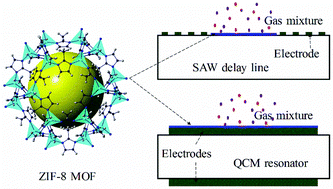Our official English website, www.x-mol.net, welcomes your feedback! (Note: you will need to create a separate account there.)
Zeolitic imidazolate framework-coated acoustic sensors for room temperature detection of carbon dioxide and methane
Nanoscale ( IF 6.7 ) Pub Date : 2018-03-26 00:00:00 , DOI: 10.1039/c7nr09536h Jagannath Devkota 1, 2, 3, 3, 4 , Ki-Joong Kim 1, 2, 3, 3, 4 , Paul R. Ohodnicki 1, 2, 3, 5, 6 , Jeffrey T. Culp 1, 2, 3, 3, 4 , David W. Greve 2, 3, 6, 7, 8 , Jonathan W. Lekse 1, 2, 3
Nanoscale ( IF 6.7 ) Pub Date : 2018-03-26 00:00:00 , DOI: 10.1039/c7nr09536h Jagannath Devkota 1, 2, 3, 3, 4 , Ki-Joong Kim 1, 2, 3, 3, 4 , Paul R. Ohodnicki 1, 2, 3, 5, 6 , Jeffrey T. Culp 1, 2, 3, 3, 4 , David W. Greve 2, 3, 6, 7, 8 , Jonathan W. Lekse 1, 2, 3
Affiliation

|
The integration of nanoporous materials such as metal organic frameworks (MOFs) with sensitive transducers can result in robust sensing platforms for monitoring gases and chemical vapors for a range of applications. Here, we report on an integration of the zeolitic imidazolate framework – 8 (ZIF-8) MOF with surface acoustic wave (SAW) and thickness shear mode quartz crystal microbalance (QCM) devices to monitor carbon dioxide (CO2) and methane (CH4) under ambient conditions. The MOF was directly coated on the Y-Z LiNbO3 SAW delay lines (operating frequency, f0 = 436 MHz) and AT-cut quartz TSM resonators (resonant frequency, f0 = 9 MHz) and the devices were tested for various gases in N2 under ambient conditions. The devices were able to detect the changes in CO2 or CH4 concentrations with relatively higher sensitivity to CO2, which was due to its higher adsorption potential and heavier molecular weight. The sensors showed full reversibility and repeatability which were attributed to the physisorption of the gases into the MOF and high stability of the devices. Both types of sensors showed linear responses relative to changes in the binary gas compositions thereby allowing to construct calibration curves which correlated well with the expected mass changes in the sorbent layer based on mixed-gas gravimetric adsorption isotherms measured on bulk samples. For 200 nm thick films, the SAW sensitivities to CO2 and CH4 were 1.44 × 10−6/vol% and 8 × 10−8/vol%, respectively, against the QCM sensitivities 0.24 × 10−6/vol% and 1 × 10−8/vol%, respectively, which were evaluated as the fractional change in the signal. The SAW sensors were also evaluated for 100 nm–300 nm thick films, the sensitivities of which were found to increase with the thickness due to the increased number of pores for the adsorption of a larger amount of gases. In addition, the MOF-coated SAW delay lines had a good response in wireless mode, demonstrating their potential to operate remotely for the detection of the gases at emission sites across the energy infrastructure.
中文翻译:

沸石咪唑盐骨架涂层声学传感器,用于室温下检测二氧化碳和甲烷
纳米多孔材料(例如金属有机框架(MOF))与敏感传感器的集成可以形成强大的传感平台,以监测各种应用中的气体和化学蒸气。在这里,我们报告将沸石咪唑盐骨架– 8(ZIF-8)MOF与表面声波(SAW)和厚度剪切模式石英晶体微天平(QCM)设备集成在一起,以监测二氧化碳(CO 2)和甲烷(CH)4)在环境条件下。MOF直接涂覆在YZ LiNbO 3 SAW延迟线上(工作频率,f 0 = 436 MHz)和AT切割石英TSM谐振器(谐振频率,f 0)上= 9 MHz),并在环境条件下测试了设备中N 2中的各种气体。该设备能够以相对较高的对CO 2的敏感性检测出CO 2或CH 4浓度的变化。,这是由于其较高的吸附潜力和较重的分子量。传感器显示出完全可逆性和可重复性,这归因于气体对MOF的物理吸附以及设备的高稳定性。两种类型的传感器均显示出相对于二元气体成分变化的线性响应,从而允许基于在散装样品上测得的混合气体重量吸附等温线,构建与吸附剂层的预期质量变化良好相关的校准曲线。对于200 nm厚的膜,SAW对CO 2和CH 4的灵敏度分别为1.44×10 -6 / vol%和8×10 -8 / vol%,而QCM灵敏度为0.24×10 -6 / vol%和1 ×10-8 / vol%分别作为信号的分数变化进行评估。还对SAW传感器的100 nm–300 nm厚膜进行了评估,发现其敏感性随着厚度的增加而增加,这是由于吸附大量气体的孔数增加所致。此外,涂有MOF的SAW延迟线在无线模式下具有良好的响应,表明了它们可以远程操作以检测整个能源基础设施排放点的气体的潜力。
更新日期:2018-03-26
中文翻译:

沸石咪唑盐骨架涂层声学传感器,用于室温下检测二氧化碳和甲烷
纳米多孔材料(例如金属有机框架(MOF))与敏感传感器的集成可以形成强大的传感平台,以监测各种应用中的气体和化学蒸气。在这里,我们报告将沸石咪唑盐骨架– 8(ZIF-8)MOF与表面声波(SAW)和厚度剪切模式石英晶体微天平(QCM)设备集成在一起,以监测二氧化碳(CO 2)和甲烷(CH)4)在环境条件下。MOF直接涂覆在YZ LiNbO 3 SAW延迟线上(工作频率,f 0 = 436 MHz)和AT切割石英TSM谐振器(谐振频率,f 0)上= 9 MHz),并在环境条件下测试了设备中N 2中的各种气体。该设备能够以相对较高的对CO 2的敏感性检测出CO 2或CH 4浓度的变化。,这是由于其较高的吸附潜力和较重的分子量。传感器显示出完全可逆性和可重复性,这归因于气体对MOF的物理吸附以及设备的高稳定性。两种类型的传感器均显示出相对于二元气体成分变化的线性响应,从而允许基于在散装样品上测得的混合气体重量吸附等温线,构建与吸附剂层的预期质量变化良好相关的校准曲线。对于200 nm厚的膜,SAW对CO 2和CH 4的灵敏度分别为1.44×10 -6 / vol%和8×10 -8 / vol%,而QCM灵敏度为0.24×10 -6 / vol%和1 ×10-8 / vol%分别作为信号的分数变化进行评估。还对SAW传感器的100 nm–300 nm厚膜进行了评估,发现其敏感性随着厚度的增加而增加,这是由于吸附大量气体的孔数增加所致。此外,涂有MOF的SAW延迟线在无线模式下具有良好的响应,表明了它们可以远程操作以检测整个能源基础设施排放点的气体的潜力。


























 京公网安备 11010802027423号
京公网安备 11010802027423号